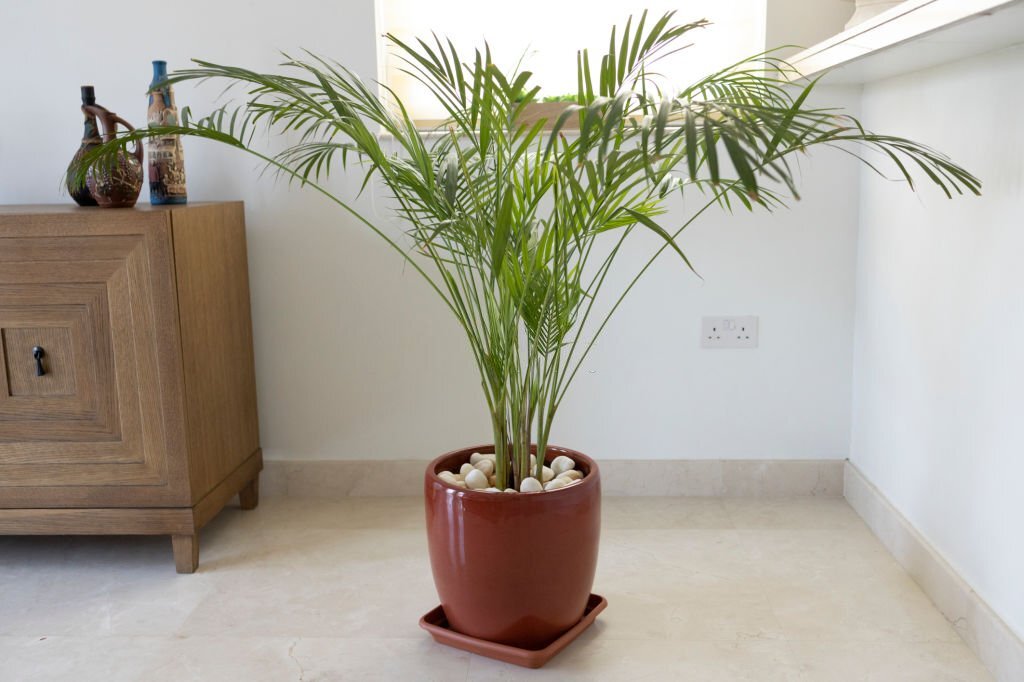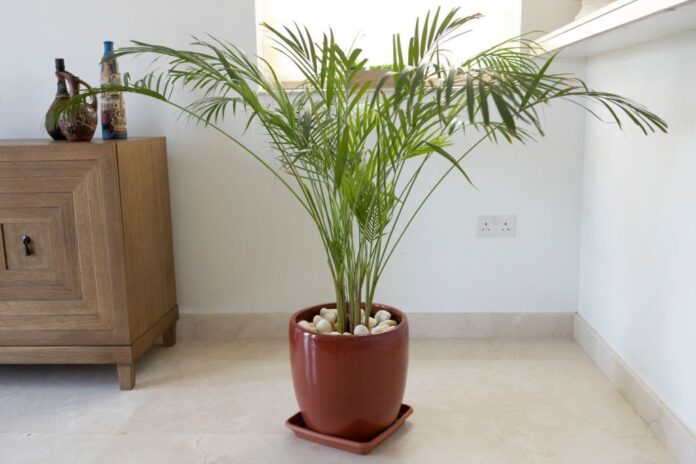Introduction to the Cat Palm: A Beautiful Addition to Your Home
The cat palm, also known as Chamaedorea cataractarum, is a popular houseplant that adds a touch of elegance and beauty to any home. With its lush green fronds and graceful arching stems, the cat palm is a favorite among plant enthusiasts. It is native to Mexico and Central America and thrives in tropical and subtropical climates.
One of the reasons why the cat palm is a great addition to any home is its ability to purify the air. Like many other houseplants, the cat palm helps to remove toxins from the air, improving indoor air quality. It also adds a touch of nature and greenery to your living space, creating a calming and relaxing atmosphere.
In addition to its aesthetic appeal and air-purifying properties, the cat palm is also relatively easy to care for. It can tolerate low light conditions, making it suitable for homes with limited natural light. It also has moderate water requirements, so you don’t have to worry about constantly watering it. Overall, the cat palm is a low-maintenance plant that can thrive in various indoor environments.

Choosing the Right Location: Where to Place Your Cat Palm
When it comes to finding the perfect spot for your cat palm, there are a few factors to consider. First and foremost, lighting conditions play a crucial role in the health and growth of your plant. While cat palms can tolerate low light conditions, they still require some indirect sunlight to thrive. Ideally, place your cat palm near a window that receives bright, indirect light for a few hours each day.
Temperature and humidity are also important considerations when it comes to placing your cat palm. These plants prefer temperatures between 60-80°F (15-27°C) and high humidity levels. If you live in a dry climate or during the winter months when indoor heating can cause low humidity, consider using a humidifier or placing a tray of water near your cat palm to increase humidity levels.
When choosing the location for your cat palm, it’s also important to consider the size of the plant. Cat palms can grow up to 6 feet tall, so make sure you have enough space for it to grow and spread its fronds. Avoid placing it in high-traffic areas where it may get bumped or knocked over.
Soil and Watering Requirements: How to Keep Your Cat Palm Healthy
Cat palms prefer well-draining soil that is slightly acidic to neutral in pH. A good potting mix for cat palms should contain a combination of peat moss, perlite, and sand to ensure proper drainage. Avoid using heavy soils that retain too much moisture, as this can lead to root rot.
When it comes to watering your cat palm, it’s important to strike a balance. Overwatering can lead to root rot and other fungal diseases, while underwatering can cause the plant to dry out and wilt. The frequency of watering will depend on various factors such as the size of the plant, the temperature and humidity levels in your home, and the type of potting mix used.
As a general rule, water your cat palm when the top inch of soil feels dry to the touch. Use room temperature water and thoroughly saturate the soil until water drains out of the bottom of the pot. Empty any excess water from the saucer to prevent waterlogging.
Fertilizing Your Cat Palm: Tips for Optimal Growth
To promote optimal growth and keep your cat palm healthy, it’s important to fertilize it regularly. Use a balanced liquid fertilizer specifically formulated for houseplants. During the growing season, which is typically spring and summer, fertilize your cat palm every 2-4 weeks. In the winter months, reduce fertilization to once every 6-8 weeks.
When applying fertilizer, dilute it to half the recommended strength to avoid overfertilization, which can burn the roots of the plant. Apply the fertilizer to moist soil, as this will help prevent root damage. Be sure to follow the instructions on the fertilizer packaging for best results.
Signs of nutrient deficiencies in cat palms include yellowing or browning of the leaves, stunted growth, and overall poor health. If you notice any of these signs, it may be a sign that your cat palm needs additional nutrients. Consider increasing the frequency or strength of your fertilization routine or consult a plant expert for further guidance.
Pruning and Trimming: Maintaining the Shape of Your Cat Palm
Pruning and trimming are essential for maintaining the shape and appearance of your cat palm. It’s important to prune away any dead or yellowing fronds to promote new growth and prevent the spread of diseases. Additionally, removing any overcrowded or crossing stems can help improve air circulation and prevent pests from taking hold.
The best time to prune your cat palm is in early spring before new growth begins. Use clean, sharp pruning shears or scissors to make clean cuts. Avoid tearing or ripping the fronds, as this can cause damage to the plant.
When pruning, be sure to remove only the dead or damaged fronds, as removing too many healthy fronds can stress the plant. Aim to maintain a balanced and symmetrical shape by removing any fronds that are significantly longer or shorter than the rest.
Dealing with Pests and Diseases: Protecting Your Cat Palm
While cat palms are relatively resistant to pests and diseases, they can still be susceptible to certain issues. Common pests that may affect cat palms include spider mites, mealybugs, and scale insects. These pests can cause damage to the leaves and stems of the plant, leading to stunted growth and overall poor health.
If you notice any signs of pest infestation, such as webbing, sticky residue, or small insects on the plant, it’s important to take action immediately. There are both natural and chemical treatments available for dealing with pests on cat palms.
For natural treatments, you can try using a mixture of water and mild dish soap to create a soapy spray. Apply the spray to the affected areas of the plant, making sure to cover both the tops and bottoms of the leaves. Repeat this treatment every few days until the pests are eliminated.
If natural treatments are not effective, you may need to resort to chemical pesticides. Be sure to choose a pesticide that is specifically formulated for use on houseplants and follow the instructions carefully. Keep in mind that chemical pesticides can be harmful to humans and pets, so use them with caution and keep them out of reach.
In addition to pests, cat palms can also be susceptible to certain diseases such as root rot and leaf spot. These diseases are often caused by overwatering or poor drainage. To prevent these issues, make sure your cat palm is planted in well-draining soil and avoid overwatering.
Propagation Methods: How to Multiply Your Cat Palm
If you want to multiply your cat palm and create more plants, there are two main methods of propagation: division and seeds.
Propagation by division involves separating the plant into smaller sections, each with its own roots and stems. To propagate your cat palm by division, carefully remove the plant from its pot and gently separate the roots into smaller clumps. Make sure each clump has at least one healthy stem and a good amount of roots. Plant each division in its own pot with fresh potting mix and water thoroughly.
Propagation by seeds is another option, although it can be a slower process. To propagate your cat palm from seeds, collect ripe seeds from a mature plant and sow them in a seed tray or small pots filled with a well-draining potting mix. Cover the seeds lightly with soil and keep them moist. Place the tray or pots in a warm, bright location, but out of direct sunlight. Germination can take several weeks to months, so be patient.
Transplanting Your Cat Palm: When and How to Do It
Transplanting your cat palm is necessary when it outgrows its current pot or when the soil becomes compacted and waterlogged. Signs that your cat palm needs to be transplanted include roots growing out of the drainage holes, slow growth, and yellowing leaves.
To transplant your cat palm, choose a pot that is one size larger than its current pot. Fill the new pot with fresh potting mix and create a hole in the center. Carefully remove the plant from its current pot, taking care not to damage the roots. Place the plant in the new pot, making sure it is centered and at the same depth as before. Fill in any gaps with additional potting mix and gently press it down to secure the plant.
After transplanting, water the plant thoroughly to help settle the soil and remove any air pockets around the roots. Place the plant in a location with bright, indirect light and monitor its progress over the next few weeks. Avoid fertilizing for at least a month after transplanting to allow the plant to adjust to its new environment.
Decorating with Cat Palms: Ideas for Incorporating Them into Your Home
Cat palms can be a versatile and stylish addition to your home decor. Their lush green fronds can add a touch of nature and freshness to any room. Here are some ideas for incorporating cat palms into your home:
1. Living Room: Place a cat palm in a decorative pot near a window or in a corner of your living room to create a focal point and add a pop of greenery.
2. Bedroom: Create a calming and relaxing atmosphere in your bedroom by placing a cat palm on a nightstand or dresser. The plant’s natural beauty can help promote a sense of tranquility and serenity.
3. Bathroom: Cat palms thrive in high humidity environments, making them perfect for bathrooms. Place a small cat palm on a shelf or countertop to add a touch of greenery to your bathroom decor.
4. Office: Bring some life and energy to your workspace by placing a cat palm on your desk or nearby shelf. The plant’s air-purifying properties can also help improve the air quality in your office.
5. Entryway: Make a statement as soon as guests enter your home by placing a tall cat palm near the front door. This will create a welcoming and inviting atmosphere.
Frequently Asked Questions: Answers to Common Questions About Cat Palms
1. How fast do cat palms grow?
Cat palms are relatively slow-growing plants, especially when grown indoors. On average, they can grow up to 6 inches per year.
2. Can cat palms be grown outdoors?
While cat palms are primarily grown as houseplants, they can be grown outdoors in tropical and subtropical climates. They prefer partial shade and well-draining soil.
3. How often should I repot my cat palm?
Cat palms should be repotted every 2-3 years or when they outgrow their current pot. Signs that your cat palm needs repotting include roots growing out of the drainage holes and slow growth.
4. Can I place my cat palm outside during the summer months?
Cat palms can be placed outside during the summer months, but they should be protected from direct sunlight and extreme temperatures. Gradually acclimate the plant to outdoor conditions to prevent shock.
Conclusion:
In conclusion, the cat palm is a beautiful and versatile plant that can enhance the aesthetic appeal of any home. With its lush green fronds and low-maintenance nature, it is a great choice for both beginner and experienced plant enthusiasts. By providing the right lighting, temperature, and humidity conditions, as well as proper soil and watering, you can ensure the health and longevity of your cat palm. With regular pruning, fertilizing, and protection against pests and diseases, your cat palm will thrive and bring joy to your home for years to come. So why not give it a try and add a cat palm to your indoor plant collection?



